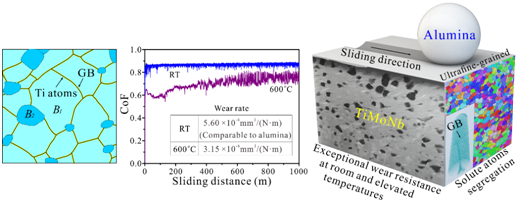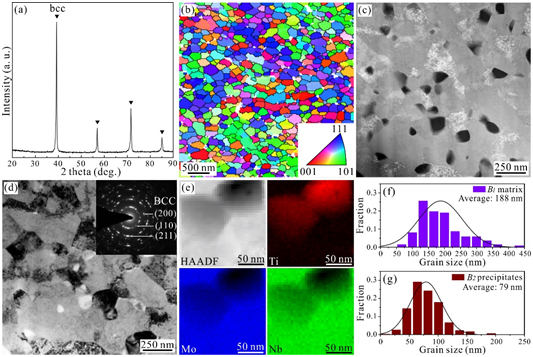Wear of alloys could soon become extremely low, thanks to research by material scientists at universities across the Greater Bay Area.
Assistant Professor Fuzeng Ren (Department of Materials Science and Engineering) has led his research team to make essential findings in the development of novel wear-resistant alloys. His team’s research results have been published in the high-impact top journal Acta Materialia (IF = 7.293) titled “Achieving exceptional wear resistance in a compositionally complex alloy via tuning the interfacial structure and chemistry.” The team proposed a novel strategy to achieve ultra-high wear resistance through tuning the grain boundary structure and chemical composition of the alloy.

The sliding wear is of high importance when considering the service life of mechanical components, so the development of new alloys with ultralow wear rate is essential for engineering components working in harsh conditions. Temperature, pressure, acidity, and stress can all influence the wear performance of a material. As a result, manufacturers have different requirements for different components, depending on the environment.
Titanium (Ti) alloys have demonstrated high strength, extraordinary corrosion resistance, excellent biocompatibility, and the ability to withstand extreme temperatures. These remarkable properties enable titanium alloys to be used in a variety of applications ranging from medical, dental, automotive, aerospace, and other industries. However, they perform poorly when they come to wear resistance leading to failure of the medical implants and engineering components. Thus it’s of crucial importance to improve the wear resistance of the Ti-based alloys.
On this basis, the researchers opted for an equiatomic alloy composed of Ti, molybdenum (Mo), and niobium (Nb) as a research model. They conferred the alloy with exceptional wear resistance both at room and elevated temperatures via a conbinated tactic containing nanostructuring, complexion engineering, as well as the formation of a high density of coherent nanoscale precipitates at the grain boundaries.
They chose these three elements together for several reasons. Firstly, these three elements are miscible in a wide temperature range, allowing them to form an excellent solid solution instead of the intermetallic compound. Secondly, all three elements are of close atomic radii and the same crystal structure, which helps form a coherent interface. Thirdly, at high temperatures of around 850 °C, a minor amount of Ti would precipitate from the matrix, further improving the strength. Fourthly, all three elements are commonly applied in alloys that operate in high-temperature environments. Fifthly and finally, all of them are relatively lighter elements in the refractory family, thereby providing a lightweight refractory alloy.

Figure 1. Phase and microstructure of the bulk TiMoNb alloy. (a) XRD pattern; (b) EBSD inverse pole figure map; (c) HAADF-STEM image; (d) bright-field TEM image of (c) and corresponding SAED patterns (inset); (e) EDS elemental maps; (f) grain size distribution of the B1 matrix and (g) grain size distribution of the B2 precipitates.
Following the fabrication of their TiMoNb alloy, they tested the wear resistance using alumina (Al2O3) balls as the counterbody. They found that the wear rate of the TiMoNb alloy is comparable to alumina at room temperature (RT). Even at high temperature (600 ℃), the alloy still shows an extremely low wear rate, several orders of magnitude lower than previously reported in traditional Ti-alloys.

Figure 2. Interface analysis of TiMoNb alloy. (a) HRTEM image of the two neighboring B1 and B2 grains; (b) and (c) are IFFT and corresponding FFT (insets) images of the B1 and B2 grains in (a), respectively; (d) HRTEM image of the two neighboring B1 grains; (e) three-dimensional reconstruction of 50 at.% Ti isoconcentration surface with highlighted B2 precipitates; (f) proximity histogram showing the composition change across B1 matrix and B2 precipitates. Error bars, s.d.; (g) atom map of Ti demonstrating segregation of Ti atoms at the GBs between two abutting B1 grains; (h) one-dimensional concentration profiles of Ti, Mo and Nb in the selected region in (g) (marked by the gray cylinder); and (i) a schematic diagram shows the microstructure of the TiMoNb alloy.
These research results offer significant insights into the design of strong, wear-resistant, and thermo-mechanically stable alloys for service in harsh environments. This study also extends the use of complexion engineering in CCAs with multi-principal elements and suggests an important and interesting direction for future research in HEAs/CCAs.
SUSTech and University of Macau joint-trained doctoral candidate Weiwei Zhu is the first author of the paper. Assistant Professor Fuzeng Ren is the sole corresponding author of the paper. Additional contributors come from the City University of Hong Kong (City U) (Dr. Junhua Luan) and the Hong Kong Polytechnic University (PolyU) (Dr. Zengbao Jiao). SUSTech is the first and corresponding affiliation.
This work was financially supported by the Fundamental Research Program of Shenzhen and Guangdong Innovative & Entrepreneurial Research Team Program. APT research was conducted at the Inter-University 3D APT Unit of City University of Hong Kong (CityU), which is supported by CityU. This work was also supported by the Pico Center at SUSTech that receives support from the Presidential fund and Development and Reform Commission of Shenzhen Municipality
Paper link: https://doi.org/10.1016/j.actamat.2020.02.039
Proofread ByXia Yingying
Photo ByDepartment of Materials Science and Engineering, Qiu Yan